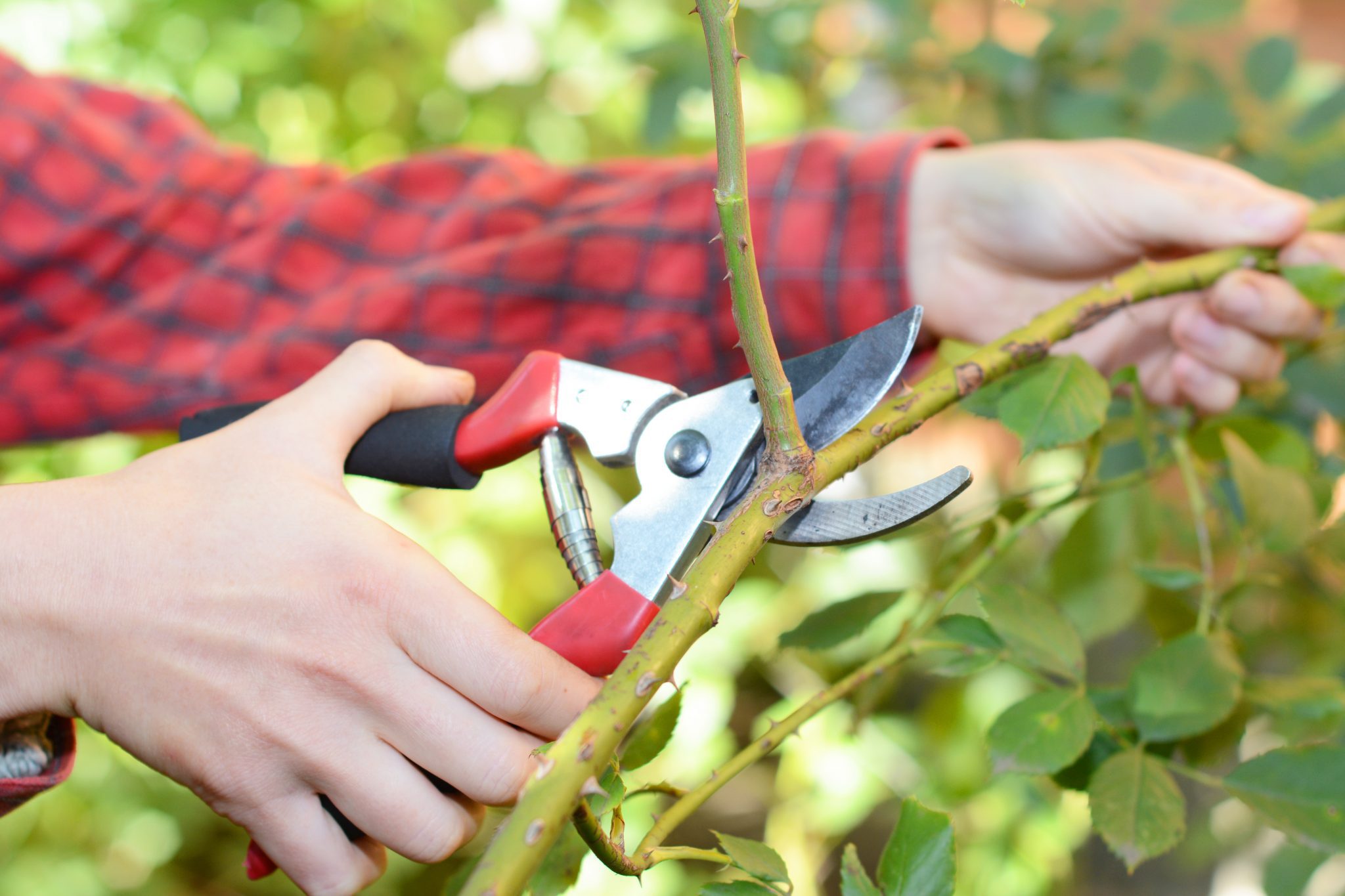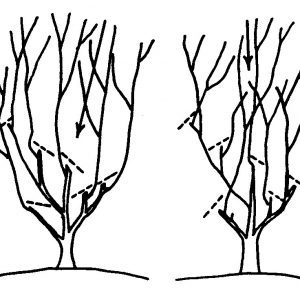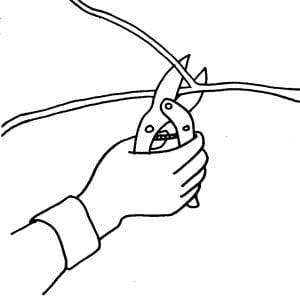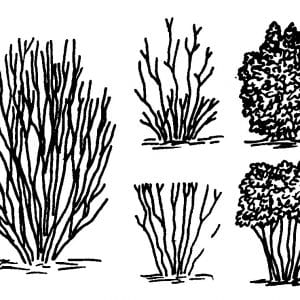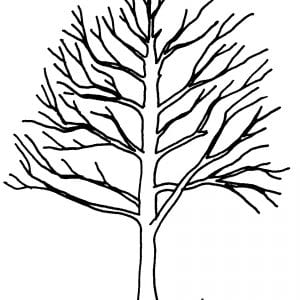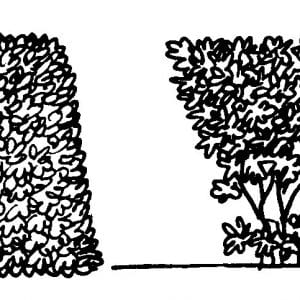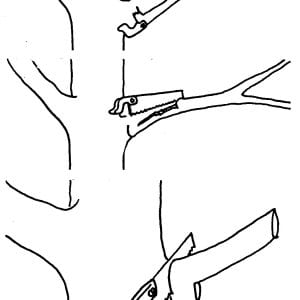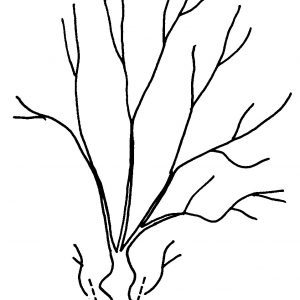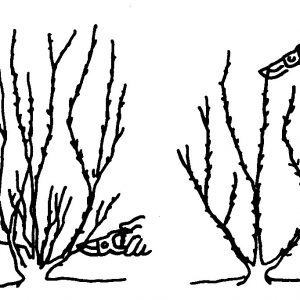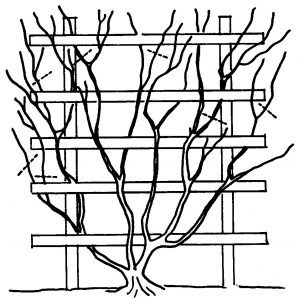Landscaping

Learn the best methods to control a plant’s shape, encourage flower or fruit production, and discourage disease.
The health and beauty of ornamental plants depend to a great extent on proper pruning. Pruning allows you to control the plant’s shape (formal or informal), encourage flower or fruit production, and discourage disease by letting light and air into the interior of the plant. This is called cultural pruning.
For most plants, pruning is recommended during dormancy (after first frost and before growth begins in spring) or immediately after flowering. Cultural pruning is done on a seasonal or annual basis. Urgent pruning is done for safety reasons, such as removal of limbs that pose a hazard to people or buildings, or to remove broken, diseased, or dead parts of a plant.
Successful Pruning
The key point to understand about pruning is that the new growth stimulated by pruning develops close to where the cut is made. The bud at the end of a branch, called the terminal bud, releases growth hormones that suppress buds along the branch length, lateral buds, from growing. Making the cut close to another bud minimizes regrowth to that one, single bud. It will then start to grow, becoming the new terminal bud. This reduces sucker growth.
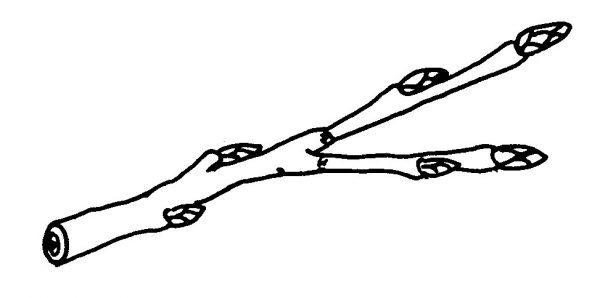
Pruning removes growing points called buds.
If you have a branch that extends beyond the canopy of a shrub, or beyond where you want it, and you make your cut at that point, both repressed buds and dormant buds may grow. This creates dense, bushy growth at the branch tips, shading out the leaves below, and makes a plant look leggy. Making your cut inside the canopy of foliage will supress excessive new growth; however, the foliage will develop where it’s needed for a fuller, more attractive shrub.
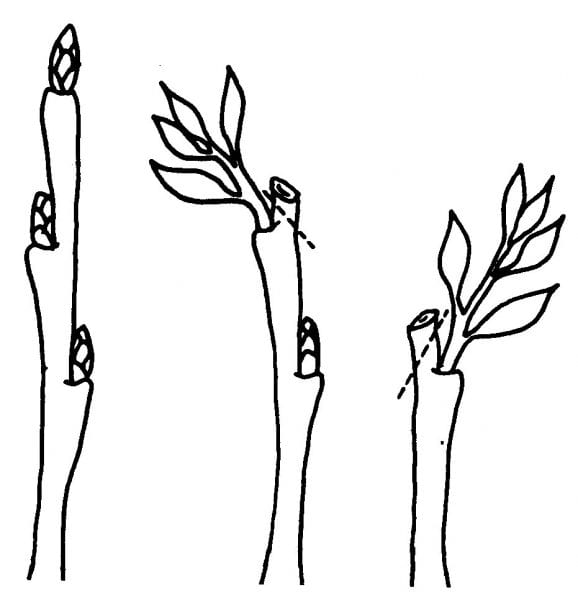
Pruning has a localized effect in that most of the new growth occurs near the cut.
This basic principle applies to almost all ornamentals. For complete pruning success, use the specific pruning techniques appropriate to your particular plants at the right time, and use the correct pruning tool.
Time to Prune
Flowers or Fruit
Different plants produce flowers at different times of the year. The buds that produce these flowers also form at different times of the year. Your pruning schedule should be based on accurate knowledge of the particular plant. If the plant begins blooming before May, prune immediately after blooms fade; if it begins to bloom in May or later, prune in late February or early March, before the start of new spring growth. This is called the May Rule.
Foliage
Plants grown primarily for their green foliage, such as hollies and boxwoods, can be pruned from January through midsummer.
Renewal Pruning
Some shrubs can be given a new lease on life through severe renewal pruning. This requires cutting the whole plant down to a stump. This can be done on most broadleaf shrubs, such as hollies, azaleas, and camellias.
Hollies, azaleas, and other nongrafted plants should be pruned to within 4 to 6 inches of the ground. Grafted plants, such as some camellias, should be pruned to within 14 to 16 inches of the ground to avoid stimulating growth from the root stock below the graft.
Junipers and boxwoods should never be pruned to stubs. Narrow-leaf plants, like junipers, do not have buds on their main trunks, and often die after renewal pruning. Boxwoods can produce growth from dormant buds, but it is often too slow for good health of the plant.
The time for severe renewal pruning is just before new growth starts in the spring. In southernmost Alabama, Mobile to Dothan, February 15 is a good target date for renewal pruning; in the south central region, including Phenix City, Montgomery, and Selma, March 1; in north central Alabama, including Birmingham and Anniston, March 5; and in the region north of Gadsden, including Florence, Decatur, and Huntsville, March 10. Avoid renewal pruning in periods of drought.
Click on images to see full scale
- Single trunk ornamentals can be pruned to open the center (left) and encourage a spreading form or to keep the plant upright (right).
- To preserve the natural form of a plant, prune to a lateral branch one third the diameter of the branch being pruned.
Informal Shrubs
Single Trunk
To maintain a natural, informal effect on single trunk ornamental shrubs, always prune branches back to a lateral branch or a bud. A good rule of thumb is to prune to a lateral branch that is one-third the diameter of the branch being removed.
Another consideration is the direction of the new growth. Simply prune to a bud or branch pointing in the direction in which new growth is desired. Leave less than 1⁄2 inch of stub to keep injury to a minimum.
Multiple Trunk Large Shrubs
Large shrubs and small trees with multiple trunks, such as crapemyrtle, need some annual pruning using the guidelines for single trunk plants. Diseased, weak, broken, or unwanted trunks should be removed.
Multiple Trunk Small Shrubs
Multiple trunk small shrubs are also known as cane-type shrubs. Examples of these include nandina, spiraea, and abelia. Older branches of these plants should be cut to the ground annually. For vertical shrubs, like nandina, start a sequence. Prune one-third of the canes to the ground, prune another third halfway to the ground, and leave the remaining canes uncut. After this initial pruning, annually remove the tallest canes to the ground. This will result in foliage and berries from the ground to the top.
Click on images to see full scale
- When a multiple trunk, cane-type shrub needs pruning (left), remove one-third of the canes to the ground and cut one-third halfway to the ground to encourage new growth throughout the plant (upper figures). Pruning only the tops will result in new growth only at the top (lower figures).
- Remove V-crotches (narrow-angled) and crossing branches, which create weakness in a tree.
- To maintain a formal hedge, the sides must be sloped slightly to make the top narrower than the bottom (left). Pruning the side vertically will shade the lower leaves and result in leggy growth (right).
Formal Hedges
Trimmed, formal-type hedges should be pruned so that they are wider at the bottom than at the top. If the sides of the hedges are pruned vertically, the lower branches may die from the shading of higher branches. This exposes the trunks of the hedge and will not be attractive.
Trees
A young tree needs pruning to build a strong framework and, quite often, to correct developing faults. Prevent formation of V-crotches and crossing of limbs. Prune young trees annually to plan for sturdiness and long life. This usually eliminates the need to remove large branches later, and it saves the cost of hiring professional tree workers.
Trees should not be topped. Topping can ruin the beauty of a tree and defeat the purpose of pruning. Topping promotes thicker, more rapid growth of suckers and water sprouts. Soft, new, rapidly growing branches are easily damaged by wind. Also, large cut surfaces are susceptible to insects and disease.
Any wound must close over if the plant is to stay healthy. Wound dressings do not help the healing process. In general, the tree is able to close over the wound itself. This is why it is important to make the final pruning cut close to the main trunk. See the illustration on the next page of the three steps.
Prune old, established trees during winter or early spring. Early winter pruning (December to early January) is better for some tree species (maples and elms tend to bleed if cut in active growth). Pines pruned in spring and summer are more susceptible to insect problems; they must be pruned in winter.
Removing Large Tree Limbs
Begin by cutting through about one-fourth of the diameter of the limb on the underside, 1 to 2 feet from the trunk of the tree. Make the second cut further out than the first—a distance equal to three times the diameter of the limb. This second cut removes the bulk of the limb’s weight to make precision easier in the final cut. Then cut the stub at the swollen base (branch collar) of the main trunk or as close as possible to another major limb. Leave only a narrow ledge at the top.
Click on images to see full scale
- To prune large tree limbs, follow the illustrated sequence, making the final cut close to the trunk. Smooth the edges of the final cut with a rasp or knife to encourage healing.
- When pruning shrubs that have been grafted, always remove new twigs that start below the graft.
Special Plants
Crapemyrtle
Since crapemyrtle flowers in summer, it should be pruned before new growth begins in the spring. Crapemyrtle will tolerate heavy pruning. In fact, to change a single-trunked crapemyrtle into a multi-trunk, cut it to the ground. Many trunks will sprout. If a single trunk is desired, prune as needed to keep it to a single trunk. o reduce pruning work when a shrub-sized plant is desired, select a crapemyrtle variety that naturally grows as a smaller shrub.
Camellia
Camellias do not need pruning every year. Prune camellias to maintain an attractive form. Camellia enthusiasts like to prune to a more open canopy form.
The common camellia (Camellia japonica) is normally grafted onto the roots of sasanqua camellia. Occasionally, this sasanqua root stock will sprout a sucker. These suckers should be removed completely or they may soon dominate the plant.
Some camellias bloom in the fall, some in winter, and some in spring. If pruning is needed, prune fall and winter bloomers in March. Prune spring bloomers after flowers have faded.
Hydrangea
Hydrangeas are an exception to the normal May Rule. Each species forms buds differently, but in general they should be pruned immediately after flowering. If a hydrangea fails to bloom, cut all canes back to within 2 feet of the ground in July.
Click on images to see full scale
- Prune hybrid teas in late March or after danger of cold weather passes.
- Prune climbing roses after first flush of flowering in spring. Keep plant within limits of trellis or support.
Roses
Of the many garden plants, roses respond most readily to pruning, resulting in larger blooms, more substance, and better color. Because of variations in flowering and growth habits, not all rose varieties are pruned alike. A general rule is to prune weak-growing varieties lightly and vigorous-growing varieties more severely. Carefully examine canes for wounds, split bark, or signs of disease or crowding, and remove these first.
Hybrid Teas
Prune hybrid tea rose types in early spring just before or immediately after the beginning of new growth. Immediately after the last frost date, remove canes or stems showing winter damage, disease, or insect damage. Prune the remaining canes to 15 to 18 inches above the ground. Longer canes may be left if desired. Leave a minimum of three to five of the healthiest, most vigorous canes on each plant.
All cuts should be made 1/4 inch from a bud. Use sharp, clean pruning shears.
Floribundas and Grandifloras
These roses should not be pruned as heavily as hybrid teas. Often these roses grow to a considerable height and produce more blooms. Cut back an inch below any darkened area to remove any dead and diseased wood. The entire branch should be removed if it is badly diseased or dead. Three to five strong, healthy canes should be left. Next, any small canes having weak growth or growing toward the center of the plant should be removed. Any remaining canes should be cut 18 to 24 inches above the ground, depending on the plant’s vigor.
Climbing Roses
Climbers have variable blooming habits. Many bloom in spring only. During this period, new canes develop for next season’s flowers. Cut several old canes to ground level immediately after flowering to grow new blooming stems for next year.
Some climbers bloom off and on throughout the growing season. If new canes grow on older canes instead of the plant base, remove a few older canes in spring, leaving just five or six of the most vigorous ones. Excessive side branching can also be reduced for ease of later pruning. This will keep the plant from becoming too thick and will help produce more attractive blooms and plants.
Most climber canes produce good blooms for only 2 years. Remove old, faded flower clusters on varieties that bloom throughout the growing season.
Tools for Pruning
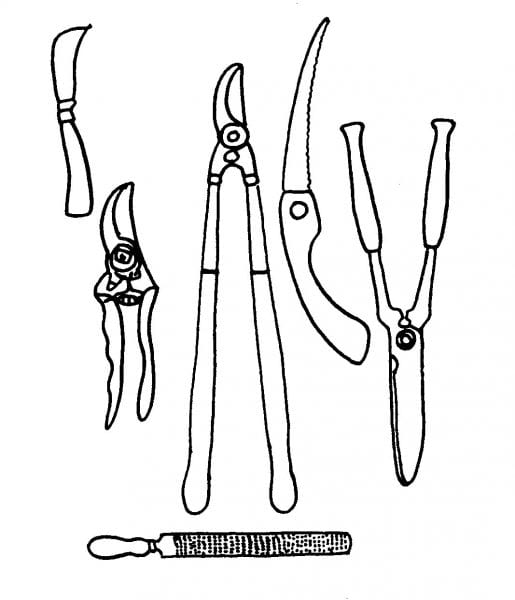
Tools used for pruning.
To do a good job of pruning, you need quality, sharp tools designed for the task at hand. The most commonly used is hand pruners. These shears can be used on branches 3/4 inch in diameter or smaller. There are two types, anvil and scissors. The anvil type is lighter and less expensive, but it crushes a small portion of stem. Used properly, the scissors-type cuts closer without crushing the stem and usually lasts longer.
Lopping shears are used on branches up to 1 1⁄2 inches in diameter (approximately). They vary in handle length from 20 to 36 inches. They are also available in scissors or anvil types, but in this case most anvil types are more expensive, with gear-assisted jaws for heavy-duty work.
Branches over 1 1⁄2 inches in diameter require a saw. Pruning saws have coarse teeth and a curved blade designed for fast cutting on the pull stroke. For very large limbs, a large saw or chain saw is the best choice. A pruning knife or wood rasp is useful to smooth edges of large branch cuts to promote rapid healing.
Hedge shears are designed for clipping shrubs to a formal appearance. If formal is not your style, you won’t need this tool. Boxwoods, Japanese hollies, dwarf yaupon, and other plants with many limbs and small leaves might be pruned in this way.
Keep tools sharp, lubricated, and clean. Some shears and loppers are made with removable blades, making sharpening and replacing blades easier. Clean and coat tools with light oil after use to prevent rust. When pruning diseased branches, dip the shears in a disinfectant (10 percent chlorine bleach solution or rubbing alcohol) after each cut. If you don’t use a disinfectant dip, disease will spread to healthy plants. Always clean and oil blades after using disinfectants.
 Revised by Kerry Smith, Administrator, Outreach Programs, Horticulture, Auburn University. Originally written by Dave Williams, Professor Emeritus, and Ron Shumack, Professor Emeritus, both with Auburn University
Revised by Kerry Smith, Administrator, Outreach Programs, Horticulture, Auburn University. Originally written by Dave Williams, Professor Emeritus, and Ron Shumack, Professor Emeritus, both with Auburn University
Revised August 2022, Woody Landscape Plants: Pruning, ANR-0258

